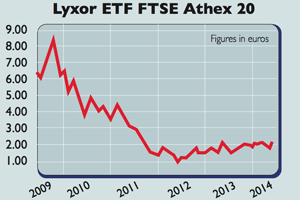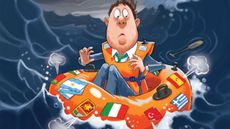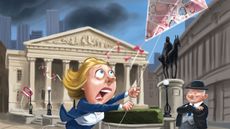Why Europe needs QE – now
QE may cause problems, but the alternative is a nasty depression. Expect the EU to start the printing presses soon, says James Ferguson.

Quantitative easing (QE) may cause problems, but the alternative is a nasty depression.Expect the EU to start the printing presses soon, says James Ferguson.
European Central Bank (ECB) boss Mario Draghi is famous for saying that he'd do "whatever it takes" to save the euro. This declaration, made at the height of the crisis in summer 2012, calmed the markets, and as a result Draghi has not actually had to do very much. But now the ECB is getting worried.
Draghi's clever game of bluff persuaded markets that he wouldn't allow a eurozone country to go bust. But while this bought the region some time, it hasn't had any practical impact on the economy.
Subscribe to MoneyWeek
Subscribe to MoneyWeek today and get your first six magazine issues absolutely FREE

Sign up to Money Morning
Don't miss the latest investment and personal finances news, market analysis, plus money-saving tips with our free twice-daily newsletter
Don't miss the latest investment and personal finances news, market analysis, plus money-saving tips with our free twice-daily newsletter
Growth in the money supply and bank lending is sliding slowly but inexorably towards 0%. As a result, so are economic growth and inflation. The ECB has slashed its inflation forecast for 2014 to 0.7%, an optimistic 1.1% in 2015 and 1.4% in 2016.
Given that the ECB is meant to keep eurozone inflation at just below the 2% level, that suggests the central bank has some work to do.
Yet, before last week, interest rates were already almost as close to zero as they could go. So what's the solution? Well, Alfred Einstein defined insanity as constantly repeating a given action while expecting a different outcome. But Draghi is clearly no physicist.
Last week, he cut rates yet again. So is he wasting his time? Or is this just the starting point for something bigger?
At first blush, despite quite an excited initial market reaction, the ECB didn't actually do that much. We'll start with the least interesting bits. The ECB will stop sterilising' the government bond purchases it made several years back when the crisis was at its peak.
The idea behind sterilisation' is that what the ECB gave with one hand (in this case, buying the government debt of troubled eurozone nations), it took away with the other it tried to suck money back out of the system by encouraging banks to deposit money back at the ECB, rather than lend it out.
The goal was to stop the bond purchases from driving inflation higher (which helped the ECB get the original scheme past the Germans in the first place). But sterilisation was always intermittent at best, so withdrawing it will make little if any difference.
The ECB also cut its benchmark interest rate (the equivalent of the Bank of England's headline rate) from 0.25% to 0.15%. It cut the marginal lending rate the rate at which banks can borrow money overnight from their national central bank from 0.75% to 0.4%.
But given that the overnight EONIA rate (the overnight rate that banks pay to borrow from one another) was already below that, at about 0.19%, these reduced rates are just playing catch-up with the market.
More eye-catchingly, the ECB cut the deposit rate for banks from 0% to -0.1%. So it now costs banks money to hold reserves with the ECB. (Of course, banks charge us for our current accounts all the time, so they should be familiar with the concept.)
The goal is to encourage the banks to lend idle money out to the real economy, rather than let it languish at the central bank. But again this is not as significant as it sounds.
At one point during the crisis, bank deposits at the ECB went as high as €828bn. However, now only around €33bn is sitting there. The banks could take all of their funds out of the ECB en masse on a single day, and it would be no big deal at all.
There was one interesting development, amid this pointless rate tweaking. There will be €400bn of targeted long-term refinancing operation' (LTRO) funding. The ECB is planning something similar to Britain's own (failed) Funding for Lending Scheme.
The basic idea is that banks get access to cheap funds as long as they lend them out to small businesses. But details were sketchy and the launch is not until September, so the ECB is hardly taking urgent action to avert deflation.
If this all sounds like a lot of fiddling, while Rome (and the rest of Europe) burns, that's because, for the most part, it is. When asked why the ECB had not gone ahead with straightforward quantitative easing (QE), UK or US style, Draghi said: "Are we finished? The answer is no.If need be, within our mandate, we aren't finished here."
Well, I can tell you right now, he's going to have to do more I still expect to see QE in the eurozone before too long. Here's why.
The problem
Europe's core problem is that monetary policy isn't working. Or rather, the transmission mechanism is gummed up. You see, while fiscal policy taxing and spending is delivered directly by governments, the delivery of monetary policy is almost wholly subcontracted to private-sector agents the banks.
In normal times, if the ECB wants to stimulate the economy by making credit more easily available, then it cuts interest rates. The banks respond by lending more. These loans in turn create new deposits in other words, the money supply expands. More money flowing around means more demand for opportunities to invest and spend it, which means growth.
Before the crisis, loan growth in the eurozone was around a healthy 12%a year, while GDP growth was justbelow 4%. But in the first year of the crisis, loan growth fell to 0% and the economy was plunged into recession.
The ECB's main interest rate was slashed from 4.25% to just 1% in response.The troubles in Greece held the recovery back in 2010, but by 2011, bank lending had sputtered back into life, growing by2.5% a year.
The ECB, under Jean-Claude Trichet, believed the crisis was largely an American problem, and hiked rates twice in 2011, hoping for a return to normality. Then it all went horribly wrong for reasons that the European authorities still don't quite seem to understand.
Everything has slid into decline since the end of 2011. Bank-loan growth, which had stalled at a miserly 2.5%, fell back. Meanwhile, inflation rose as high as 3%, which meant that, in real' terms, bank lending was shrinking. Economic growth peaked in early 2011 at 2.75%, then headed sharply lower.
At the same time, the US, supposedly the root cause of the crisis, saw bank-capital ratios, lending and growth all recovering.
Meanwhile, the UK and even the sick man of the developed world, Japan, have apparently all returned to growth (we'll just have to wait and see how much of this apparent recovery is actually owed to QE).
Draghi to the rescue?
Then in November 2011, Draghi replaced the economically myopic Trichet as the head of the ECB. Like some B-movie action hero, he swung into action. Within a month, he had reversed Trichet's rate hikes and launched a massive €1trn LTRO to keep the banking system funded.
This stopped banks from going bust (it kept them liquid), but they were still not very well capitalised (in other words, their balance sheets were still in a bad way). Nor, given his remit and German law, could Draghi do anything to keep the money supply from shrinking he couldn't launch QE.
That's why Draghi's heroic efforts so far, including the press-pleasing, eye-catching announcements of last week, have done nothing to actually help the economy by getting bank lending going again. And that's because the banks own too little capital or to put it another way, they have too many loans.
Raising capital is not impossible, but it's very tricky. So the natural strategy for Europe's banks to follow is to reduce the number of loans they hold, by letting the old ones run off and not making new ones.
That's why the stock of eurozone loans went quietly negative in the second half of 2012, and has been shrinking with a vengeance for the last 12 months. And that's why cutting rates is near-pointless a bank that won't lend when money costs it 0.25% is not going to change its mind at 0.15%.
Draghi knows this. But having reached the end of what he could achieve by merely talking, he had to do something. But now he needs to do more.
If Europe is to make any progress, it has to go to the root of the problem of why banks can't lend, and tackle it. Banks can't lend because the regulator has warned them that they might have too little capital to back these loans.
In the autumn, the ECB's own Asset Quality Review (AQR) will be published and will shed more light on the scale of the problem. But it's likely to make matters even worse by forcing banks to redefine some loans as non-performing.
This will involve taking a loss, which will be deducted from their capital. What bank facing such an environment would increase its lending, even if the funds were very cheap? Clearly, very few.
Now, the regulator is in a tough position. If banks don't have sufficient capital, it makes them vulnerable to an economic downturn, as we've seen. That in turn triggered the immensely unpopular taxpayer bail-outs. So it's hard to blame them for taking a tough stance.
The trouble is, falling bank lending leads to a falling money supply and falling prices, as demand is choked off for want of credit. And outright deflation, which Europe is now explicitly flirting with (the consumer-price inflation is at just 0.5%), leads to economic stagnation.
You see, the deflation that Europe faces is nobenign super-sale, where the prices of things that Europeans want to buy keeps getting cheaper. A falling money supply is best described as a depression a prolonged slump that no amount of ECB liquidity can mitigate. You just need to look at what happened in Greece, Portugal and Ireland to see the effects.
The US, the UK and, more recently, Japan, have aimed to avoid this by starting up their printing presses instead. QE does little to support banks, but it does go some way towards bailing out their customers.
And while the banks get on with the painful process of fixing their balance sheets over a number of years, QE prevents the rest of the economy having to endure deflationary depression.
There's one big drawback, of course if the initial problem was caused by a credit bubble and all the capital-allocation inefficiencies which that entailed, then these inefficiencies get baked into the cake during QE. That makes the eventual resolution potentially even more chronic as the UK may find in the longer run.
Who will benefit from QE?
But that's the long run. What is clear now is that the ECB has run out of road. Banks will keep reining in lending, meaning money-supply growth will go negative. All the ECB can do to mitigate the damage is keep money-supply growth on artificial life support via QE.
This is not perfect by any means QE money enters the economy from the top, so it can't filter down to the areas usually served by the banks. That means it disproportionately favours other areas of the economy (the corporate, wealthy and financial sectors).
So frankly, it's not the sort of thing that will make life immediately easier for small companies, or the average person on the street. But it does beat a nasty depression. And it does offer opportunities for investors.
QE money tends to flow into the stock markets and high-end property to the sectors and regions that need it least leaving small businesses and most households without access to affordable credit. That means QE will be very good for European stocks, especially multinationals and those based in stronger countries, such as Germany.
QE also dilutes the currency it proved harmful to the value of the dollar and the pound, and more recently the yen. The same is likely for the euro. So firms that export outside the eurozone should do well too. We look at promising markets and stocks in the box on page 28.
James Ferguson is a founding partner of the MacroStrategy Partnership LLP (www.macrostrategy.co.uk) and regularly contributes to MoneyWeek.
The four investments to buy now

As James notes above, if Europe wants to avoid deflation, then it needs to use QE to keep the money supply in the eurozone growing, while the region's banks are cutting lending as they try to repair their own balance sheets, writes John Stepek.
QE will, of course, have its own troublesome side effects in the long run, but if one of the central bank's goals is to keep inflation at around 2% (which it is), then QE is one of the few ways to do it.
The main reason the ECB has yet to embark on QE is that Mario Draghi is in a much tougher position politically than any other major central banker in the world.
While politicians in most nations are quite happy for their central banks to keep credit as cheap as possible, Germany, the most powerful eurozone nation, neither needs nor particularly wants looser monetary policy. This resistance has made it tricky for Draghi to do much more than talk in recent years.
But now, with eurozone inflation significantly below the ECB's target, Draghi's latest actions suggest that he feels things are drastic enough to give him permission to act.
While full-blown QE might be a while off yet, the important thing is that markets now believe it's possible, whereas before last week, Draghi was in danger of losing his hard-won credibility if he'd sat on his hands yet again.
So, what does that mean for investors? Well, as we've seen everywhere else in the world from the US to the UK to Japan QE tends to boost stock market prices, while weakeningthe currency.
So, should a sterling investor hedge their currency exposure? We wouldn't worry too much about it. The ECB would clearly like the euro to be weaker than it is today, but it doesn't want the single currency to collapse either.
Overall, we'd expect share-price gains to more than offset currency losses. So what should you buy?
We've been recommending buying the peripheral' stock markets since summer 2012, and they've done very well since. They're not as cheap as they were, but we'd happily stick with them Spain, Portugal, Italy, Ireland and Greece remain among the ten cheapest markets in the world judged by their cyclically adjusted price/earnings ratios (Cape), according to Mebane Faber of Cambria Investment Management in fact, Greece is the cheapest in the world by Cape, even though it's up by nearly 100% in the last two years.

The iShares FTSE MIB (LSE: IMIB) exchange-traded fund tracks the Italian market, and the Lyxor ETF FTSE Athex 20 (Paris: GRE) gets you access to the Greek market.
If the periphery still feels too risky for you, think about the opposite end of the spectrum Germany. A cheaper euro would be good for Germany's already formidable export machine. One interesting play could be to invest in car manufacturer Daimler (Dax: DAI), which JP Morgan analysts reckon looks better value at the moment than rival BMW.
(As a side note, anything that makes German exporters even more competitive will make life tougher for Germany's rivals and potentially spur more money printing from the Japanese. Take a look at page 36 to see how you could benefit from more stimulus in Japan too.)
Overly loose monetary policy also tends to lead to property and consumer-spending booms, which we're already seeing starting in Germany. So if youre looking for a general play on Germany, you could go for an exchange-traded fund such as the Lyxor ETF DAX (Paris: DAX), which tracks the German Dax index.
James Ferguson qualified with an MA (Hons) in economics from Edinburgh University in 1985. For the last 21 years he has had a high-powered career in institutional stock broking, specialising in equities, working for Nomura, Robert Fleming, SBC Warburg, Dresdner Kleinwort Wasserstein and Mitsubishi Securities.
-
 Pension vs property: which option provides the best income for your retirement?
Pension vs property: which option provides the best income for your retirement?News With the cost of a comfortable retirement on the rise, future retirees need to weigh up which strategy offers the best returns. But is a pension a better bet than property?
By Henry Sandercock Published
-
 The industry at the heart of global technology
The industry at the heart of global technologyThe semiconductor industry powers key trends such as artificial intelligence, says Rupert Hargreaves
By Rupert Hargreaves Published
-
 Governments will sink in a world drowning in debt
Governments will sink in a world drowning in debtCover Story Rising interest rates and soaring inflation will leave many governments with unsustainable debts. Get set for a wave of sovereign defaults, says Jonathan Compton.
By Jonathan Compton Published
-
 Why Australia’s luck is set to run out
Why Australia’s luck is set to run outCover Story A low-quality election campaign in Australia has produced a government with no clear strategy. That’s bad news in an increasingly difficult geopolitical environment, says Philip Pilkington
By Philip Pilkington Published
-
 Why new technology is the future of the construction industry
Why new technology is the future of the construction industryCover Story The construction industry faces many challenges. New technologies from augmented reality and digitisation to exoskeletons and robotics can help solve them. Matthew Partridge reports.
By Dr Matthew Partridge Published
-
 UBI which was once unthinkable is being rolled out around the world. What's going on?
UBI which was once unthinkable is being rolled out around the world. What's going on?Cover Story Universal basic income, the idea that everyone should be paid a liveable income by the state, no strings attached, was once for the birds. Now it seems it’s on the brink of being rolled out, says Stuart Watkins.
By Stuart Watkins Published
-
 Inflation is here to stay: it’s time to protect your portfolio
Inflation is here to stay: it’s time to protect your portfolioCover Story Unlike in 2008, widespread money printing and government spending are pushing up prices. Central banks can’t raise interest rates because the world can’t afford it, says John Stepek. Here’s what happens next
By John Stepek Published
-
 Will Biden’s stimulus package fuel global inflation – and how can you protect your wealth?
Will Biden’s stimulus package fuel global inflation – and how can you protect your wealth?Cover Story Joe Biden’s latest stimulus package threatens to fuel inflation around the globe. What should investors do?
By John Stepek Published
-
 What the race for the White House means for your money
What the race for the White House means for your moneyCover Story American voters are about to decide whether Donald Trump or Joe Biden will take the oath of office on 20 January. Matthew Partridge explains how various election scenarios could affect your portfolio.
By Dr Matthew Partridge Published
-
 What’s worse: monopoly power or government intervention?
What’s worse: monopoly power or government intervention?Cover Story Politicians of all stripes increasingly agree with Karl Marx on one point – that monopolies are an inevitable consequence of free-market capitalism, and must be broken up. Are they right? Stuart Watkins isn’t so sure.
By Stuart Watkins Published